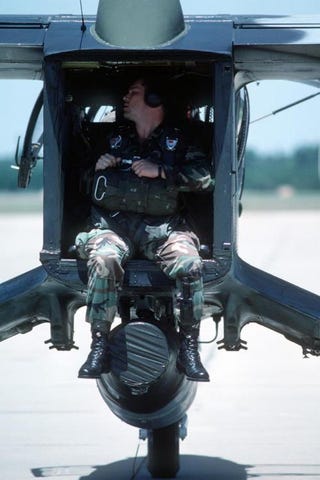
Any Gyrene fly boys on here that know or flew this aircraft?
Posted on 04/05/2015 7:53:29 PM PDT by Kartographer
The OV-10 Bronco was a flying and fighting do-all sport utility vehicle. It could loiter for hours, direct fire onto the enemy, pack paratroopers and cargo, or attack with its own weapons. Many think it was retired right when it could have become most useful and that it would have been the perfect light air support aircraft for Afghanistan and Iraq.
(Excerpt) Read more at foxtrotalpha.jalopnik.com ...

Active Duty/Retiree ping.
As a Marine grunt, I loved to watch the OV-10’s doing aerobatics west of DaNang, playing around while awaiting their next mission.
Unfortunately, they were no longer in the USMC inventory by the time I finished flight school.
Neat aircraft!
 exiting the AC was a simply matter of nose up and slide out the back...
exiting the AC was a simply matter of nose up and slide out the back... 
How many paratroopers could they possibly pack in there?
Cool!
Like a large Cessna Skyhawk with a different engine placement.
Was vulnerable to early model SAM 7 missiles
Several were lost in May 1972 during NVA offensive to
Shoulder fired SAM
One of my fav. war horses.
Couple decades later I saw a flight of them over Ft Irwin, great to see they were still going.
Very short takeoff and landing little guy, and quiet with the turboprops.
 5
5
http://www.nationalmuseum.af.mil/factsheets/factsheet.asp?id=5580
At great personal risk, Bennett decided to attack the NVA troops with his OV-10’s four 7.62 mm machine guns. In addition to large numbers of 23 mm and 37 mm antiaircraft guns used by the enemy, Bennett had to face a new threat-the new, shoulder-launched SA-7 Grail surface to air missile (SAM) carried by the NVA. Very effective against low-flying aircraft, the heat-seeking SA-7 had inflicted serious losses on American fighters. The OV-10’s twin engines produced a large amount of heat, and to stay out of the SA-7’s range, the OV-10 FACs had to fly above 9,500 feet. The area patrolled by Bennett and Brown had so many SA-7s that American pilots had nicknamed it “SAM-7 Alley.”
After four strafing attacks, Bennett had forced the NVA to retreat, and his OV-10 had received only slight damage from ground fire. On his fifth attack, however, Bennett’s left engine was hit by an SA-7, which set the engine on fire and damaged the landing gear. Another FAC pilot warned Bennett to eject because the damaged OV-10’s wing was about to explode, but Bennett refused. Shrapnel from the SA-7 had destroyed Brown’s parachute, and Bennett refused to leave Brown. Therefore, Bennett decided to ditch his aircraft in the nearby Tonkin Gulf. It was well-known by OV-10 pilots that a backseater might survive a crash-landing at sea, but the pilot’s chances of surviving were remote.
Choosing to risk his own life to save that of his backseater, Bennett landed the OV-10 in the Tonkin Gulf. Upon hitting the water, the OV-10 flipped over, and the front cockpit broke apart. Brown managed to free himself from the wreckage, but he could not help Bennett. The following day, Capt. Bennett’s body was recovered, and he was buried at Lafayette, La.
On Aug. 8, 1974, Vice President Gerald R. Ford presented the Medal of Honor to Bennett’s widow and daughter.
After rolling in on a ground attack, as they climbed out, they would roll inverted. I asked a pilot, years later, why. He said that it was easier to pull positive gees, rather than negative...
I saw one of these land and takeoff again in a parking lot at the University of South Florida. That was around 1970. Very impressive.
I think they also liked to keep track of the other planes in the flight and where they were on their runs. Looked like it could get crowded if more than one flight was working a target.
interesting
Great little airplane. Wonder what politics prevented the obvious rebirth in the COIN role?
Well, the fact that North American Aviation, the manufacturer, went bust may have had something to do with it.
Boeing has said they have had more than enough interest from foreign militaries that they are going ahead with developing and building an updated, modernized version of it with their own money even if the U.S. government says they don’t want it.
My answer will be very careful, are you of Mexican, Haitian, or caucasion Air Force decent?
I was a Vulcan air-defense gun crewman in West Germany at that time. When we did our annual aerial target practice on the Baltic coast, it was these birds that towed the targets. There was plenty of cable between the target sleeves and the Broncos themselves, so they were in no real danger.
Disclaimer: Opinions posted on Free Republic are those of the individual posters and do not necessarily represent the opinion of Free Republic or its management. All materials posted herein are protected by copyright law and the exemption for fair use of copyrighted works.